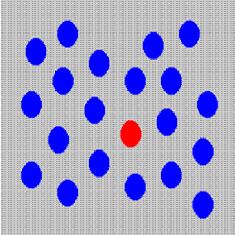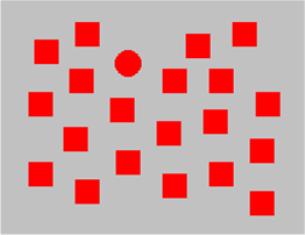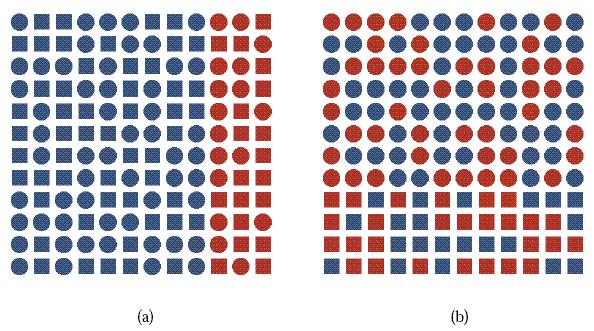Preattentive processing
Taking advantage of preattentive processing in information visualization can greatly improve intuitiveness of representations yielding in a faster and more natural way of acquiring information.
Preattentive Features
A partial list of preattentive visual features, together with references to research that showed they were preattentive.[Chipman, 1996],
Detecting the Red Object preattentively.[Healey et al., 1996] One visual variable and very easy to find it.
Detecting the Circle preattentively.[Chipman, 1996] It is more difficult but still preantentiv.
Examples of two target detection tasks: (a) target can be detected preattentively because it possess the feature “filled”; (b) target cannot be detected preattentively because it has no visual feature that is unique from its distractors.[Healey et al., 1996]
Region segregation by form and hue: (a) hue boundary is identified preattentively, even though form varies randomly in the two regions; (b) random hue variations interfere with the identification of a region boundary based on form.[Healey et al., 1996]
Conclusion
Any visual processing of that item prior to the act of selection can be called “preattentive”.[Wolfe, Treisma, 2003]
Preattentive processing can help to rapidly draw the focus of attention to a target with a unique visual feature (i.e., little or no searching is required in the preattentive case). [Healey, 2005]
External Links
- Perception in Visualization by Christopher Healey (includes many examples and applets on preattentive processing)
References
- [Chipman, 1996], Gene Chipman, Rewiev of High Speed Visual Estimation Using Preattantive Processing (Healy, Booth and Enns), Created at: 1996, Access Date: 24.October.2005. http://www.cs.umd.edu/class/spring2002/cmsc838f/preattentive.ppt#267
- [Healey, 2005]: Christopher G. Healey, Perception in Visualization, Retrieved at: 2005. http://www.csc.ncsu.edu/faculty/healey/PP/index.html
- [Healey et al., 1996], Healey, C. G., Booth, K. S., and Enns, J. T. High-Speed Visual Estimation Using Preattentive Processing. ACM Transactions on Human Computer Interaction 3(2), pages 107-135, 1996. http://www.csc.ncsu.edu/faculty/healey/download/tochi.96.pdf
- [Kosara et al., 2002],Robert Kosara, Silvia Miksch, Helwig Hauser. Focus+Context Taken Literally IEEE Computer Graphics & Applications (CG&A), Special Issue on Information Visualization, 22(1), pages 22-29, January/February 2002. http://www.kosara.net/papers/Kosara_CGA_2002.pdf
- [Treisman, 1985] A. Treisman, Preattentive Processing in Vision, Computer Vision, Graphics, and Image Processing, 31(2):156-177, August 1985.
- [Treisman, 1986] A. Treisman, Features and Objects in Visual Processing, Scientific American, 255(5):114-125, 1986.
- [Wolfe, Treisma, 2003], Jeremy M Wolfe, Anne Treisma, What shall we do with the preattentive processing stage: Use it or lose it?, Todd S Horowitz poster presented at the Third Annual Meeting of the Vision Sciences Society, Sarasota, May 2003 http://search.bwh.harvard.edu/links/talks/VSS03-JMW.pdf




